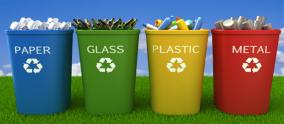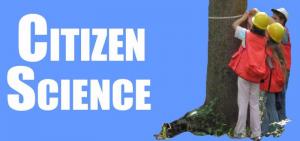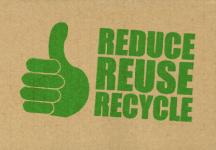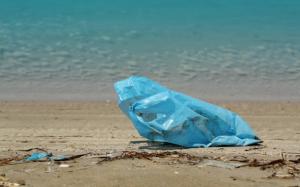November 2015 Recycling Newsletter
This articles in the Waltham Recycling Newsletter were written by Brandeis University Interns, Qiaran Yang, an international student from China, and Jacob MacKay, a New Hampshire native. It was prepared by Social Media Coordinator, Abby Auld. Qianran is a senior at Brandeis, studying East Asian Studies, and Economics & Environmental Studies. Jacob is also a senior with a double major in Music & Environmental Studies.
1. Where does our waste go?
2. Citizen Science
3. Tips for Reusing
4. Plastic Bag Pollution
Where does our waste go?
Written by Qianran Yang
Ever wonder where does our waste go? Waste management in Waltham is generally divided into four categories: Recycling, Yard Waste, Hazardous products, and Trash. Each of these tells a different story. Residents also reuse some products or donate to charities before disposals.
Reuse: Products such as old newspaper, expired milk and latex gloves could be reused (check article #3 for "Tips for Reusing"). You could donate your reusable items to charities (see: Reuse and Donation to Charities) or give away them on Freerecycle.org.
Recycling: It is taken to Casella Recycling Center in Charlestown. The facility uses sorting machines to separate recycling into different categories. Once recycling is baled, it is transported to companies that make new products.
You could also have your own compost bin and make compost on your own, for use in garden and lawn. You can buy a compost bin in Lexington Public Works Department (check information on their website here).
Trash (non-hazardous): It will be loaded into larger trucks in a transfer station first. Then the trucks will be brought to Wheelabrator, North Andover, a combustion facility. In the combustion facility, the trash is burned and turns into ash, flue gas, and heat, which will be used to generate energy.
Concerns on combustion: pollution control of smoke stack, ash recycling, and facility maintenance.
For more information on Recycling, please visit Waltham Recycling Department website.
Citizen Science
Written by Jacob MacKay
Citizen science is a movement that enlists volunteers in a non-professional role to conduct research for a non-profit organization for the government. It provides a means for harnessing a person’s activist energy, and directing that into research on specific issues. This is an exciting way to get the public engaged with environmental problems, and in the process advance some very important causes. Many people get overwhelmed when confronting environmental challenges, and think that one person’s actions could hardly make a tangible difference. And it is true, these issues do need a global response. But individuals acting together on a single problem they feel passionately about can in fact produce results. The field of citizen science is critically important to both scientists and policymakers. Volunteers can provide vital data collection services on the front lines of research and development, and can do so without scientific qualifications or experience. Governmental and non-profit organizations are constantly running outreach programs for individuals to get involved with important issues, and actually help with the research right alongside the professionals. In an ever-changing and inter-connected world, it has become easier to share and track a multitude of information, and the importance of doing so has never been greater.
There are all kinds of ways to get involved with citizen science ventures. For people who love to go outdoors and explore, there are a number of species observation and mapping assignments that are available. For example, Frog Watch USA is an initiative sponsored by the Association of Zoos & Aquariums, asking the public to report on frog calls between February and August, and upload their findings online. Volunteers begin their data collection sessions thirty minutes after sunset, and record weather conditions, information about specific calls, and any disturbances that could affect the distribution of sounds. So far, they have collected fifteen years’ worth of data, which is used for scientific research projects and case studies. Today, thousands of amphibian species are in danger of extinction, and because of their vital niche in wetlands, their absence would threaten the balance of the ecosystem. There is still so much we do not know about frog behavior, range, and natural history, and ordinary people can contribute immensely to expanding our knowledge in all of these areas.
Citizen science is not exclusively based on field work. There are also opportunities that involve data and image analysis for social justice initiatives, only requiring a computer and internet connection to complete. Geo Tag-X uses crowdsourcing technology to analyze photos from disaster relief efforts so that the officials at the United Nations can better understand how the operations could be improved. For example, through their REACH initiative, volunteers look at images of emergency shelters in the Middle East to determine whether the tents are properly equipped for winter weather. They question whether or not the shelters are raised off the ground, if they have adequate covering, or if it is safe to have a chimney installed. The professionals incorporate this analysis into their proposals to governments, humanitarians, and first responders, in an effort to improve the situation on the ground.
There are thousands of volunteer positions available in the environmental field with a wide variety of missions and subjects. Organizations around the world are seeking to capitalize on public interest, and reach out to a broader community of activists. Increasing the population of citizen scientists around the world would not only benefit the researchers themselves, but would also improve the public awareness of these issues on a larger scale. By becoming engaged individuals, we can tackle the big issues that face our planet today, and do our part to create a more informed and perceptive citizenry.
Here are two listings for citizen science projects worldwide and in New England:
Tips for Reusing
Written by Qianran Yang
How are you dealing with old newspaper, expired milk, broken latex gloves, and scraps?
Besides disposing them into recycling/trash, is there any ways we could reuse them? Here we
are presenting some tips on how we could take advantage of this waste.
Old newspaper:
1. Maintain and polish the shoes
How: Make the newspaper into balls and plug them into your shoes. It allows your recently worn
shoes to contract and prevents moisture. You could also use newspapers to wipe the black
shoes with shoe polish.
2. Clean the windows
How: It is more efficient and cleaner when you use newspaper instead of rags. The cotton in the
rag might remain on windows, making it looks even more fuzzy. The newspaper does not
contain cotton while the ink in it will make the glass brighten. In addition, the friction of
newspaper and glass will generate static electricity, which easily absorbs dust and dirt.
3. Keep the vegetables and fruits fresh
How: Before you put fresh vegetables and fruits in your refrigerator, wrap them with newspaper,
so they could be stored longer. For fruits that are still immature, such as bananas, wrap them
with newspaper and put in shady places, and they will be edible in days.
4.Clean the kitchenwares and bathtub
How: Newspaper is ideal for cleaning grease. It saves water when you use newspaper to clean
your kitchenwares and bathtub first, and then use water.
5. Make a litter box on your own
How: You can save money by making a litter box for your pets on your own. Just tear the
newspaper up and fill the litter box. The ink smell of newspaper will cover the unpleasant smell
of pets’ litter.
Expired Milk:
1.Pickle a fish dish
How: If the milk just passed expiration, you could still use it on picking a fish dish. Pour milk on
fish before cooking, and leave it for around half an hour. The milk will eliminate the fish smell
and make the meat tender.
2.Clean gold jewelries
How: Heat the milk and put gold jewelries into it. Soak for 1020
minutes and then take them
out. After washing the jewelries with clean water, rub them up with a piece of soft cloth. The
expired milk can bring back the shine of gold.
3. Mend cracked plates
How: Put cracked plates (small fissures only) into milk and heat until it boils. Then turn down to
lower heat and heat for 45 minutes. The protein of the milk will be combined with the clay in the
plates, so that the cracks will be mended.
Broken Latex Gloves:
Latex gloves are useful in daily life, but they become “useless” when you accidently break a
hole on them. However, forget the idea of disposing of them, they are still reusable if you cut the
latex gloves into bands.
1.Seal and Sort
How: Use them as rubber bands to tie bags and bottles, so the food could be easily sealed. Coil
the cables with these bands, so they could be sorted out neatly.
2. Skid proof hangars
How: Attach two bands onto each side of a hangar, and make sure the rubber surface of the
strips are on the outside. Then when you put clothes with thin straps or those made of smooth
materials, such as silk on the hangar, the clothes will not slip off.
3. Collect the hairs
How: Tie several bands on a paper tube and roll the tube on the floor or on a carpet. You could
easily collect the hairs now.
Scraps:
1. Apple/Pear Peels - clean stubborn oil stains
How: Add the peels of apple or pear into water and heat until boiling. The peels will release acid
composition that could clean up the hard grease.
2. Potato peels - clean tea stains
How: Add hot water into teacups first, and put in some potato peels. After soaking the peels for
2~3 minutes, rub the stains with the peels. The teacups will be reshining.
3. leftover beers - clean microwaves/ovens
How: The yeast of beer could effectively remove grease. So you can use a cloth or sponge
dipped with a few leftover beers to wipe your microwave or oven.
4. Expired/burnt bread - odor eliminator
How: Although expired/burnt bread is not edible, they could be used as deodorant, just like a
charcoal deodorizer. You can wrap it with paper and then use it in the refrigerator or in your
cloth closet.
Refereces: Tips for Newspapers, Tips for Expired Milk, Tips for Latex Gloves, Tips for Scraps
Plastic Bag Pollution
Written by Jacob MacKay
For many people, the ocean is a vacation destination, a place of mystical size and infinite abundance. We all love going to the beach, surfing, boating, and of course eating delicious seafood! However, few of us are aware that we are jeopardizing the resources we value by what we put into the ocean and what we take out of it. Some of the most prolific land-based pollutants are plastic bags. These materials have become a staple in American consumerism and retail. Millions of plastic bags parade through our houses and garbage cans, carrying items from groceries to clothing. Many of us never stop and think about the impact of this deluge. Plastic bags end up ensnared in trees, floating down rivers, or blowing across highways. As with many other pollutants, plastic bags often end up in the ocean, and pose a massive risk to the animals that live there.
Sea turtles have a special appetite for jellyfish. They play a unique role in the food web because turtles are some of the only species that can withstand the jellies’ stinging cells. However, with plastic bags masquerading as their favorite delicacy, sea turtles are in trouble. Plastic bags clog their digestive tracts, leading to system failure and near certain death. Because of the enormous increase of plastic production in recent decades, these majestic animals that otherwise could live past one hundred years are being threatened. According to the World Wildlife Fund, there are just over 2,000 adult female Leatherback sea turtles left in the Pacific. That is down from a global population of about 115,000 in the 1980s. Leatherback sea turtles have survived for an estimated one hundred million years, and now seem to be the species most affected by plastic bag pollution. Almost all of the sea turtle species are already classified as “endangered,” meaning they are on the pathway to extinction, and this relatively new hazard only compounds the problem.
Sea turtles are not the only marine animals impacted by plastic bags. Many fish have similar issues ingesting them accidentally, and essentially choking themselves to death. However, the problems can be traced down to the basic level. Plastic bags block sunlight, which is needed for microscopic plants called “phytoplankton” to grow. Phytoplankton in the ocean produce most of the oxygen in our atmosphere, and are the main food source for a wide range of sea creatures. In places where plastic bags pervade, these plants are unable to grow, and their absence drastically restricts the diversity of life in that area. The issue of plastic bag pollution can be viewed from many different perspectives, and not all of them are immediately obvious. The visible effects of animals eating the bags tends to be the most eye-catching, but the underlying problem of declining phytoplankton populations is also important.
Plastics in the ocean present a monumental threat, and symbolize the immense impact humans have on even the most remote parts of the planet. Because most plastics are petroleum based, they do not biodegrade, and instead are broken up into very small pieces and get caught in ocean currents. The Great Pacific Garbage Patch is the most high-profile example of where trash from the continents ends up when it gets into the water. The name implies that this section of ocean is characterized by a floating island of trash, which is true in some areas. However, the majority of this region has seen an accumulation of microplastics that have been stratified throughout the water column. The size of the Great Pacific Garbage Patch has been compared to Texas and even the entire continental United States, but in reality it is impossible to accurately measure because of the constantly-shifting and three-dimensional nature of the area. It is enough to say that vast stretches of the sea act as giant garbage receptacles from land-based sources, and not only symbolize an abstract connection between humans and the ocean, but also pose a very real threat to marine animals.
Thankfully, we as individuals can make a tangible difference just by addressing our own shopping practices. The most effective solution would be to transition to reusable bags. This calls for a significant lifestyle shift, but it would produce the most immediate results. Plastic bags are not accepted in curbside recycling because they get entangled in the machinery at disposal facilities. However, many grocery stores and shopping centers offer plastic bag recycling programs as an alternative to throwing them in the regular trash. In Waltham, Hannaford, Shaw’s, and Market Basket all have collection bins for shoppers to dispose of their plastic bags. Target in Watertown, and most Whole Foods locations offer the same service. Because we are creatures of habit, it will take a vigorous individual effort to change the way we are used to shopping. Some municipalities like Brookline have taken a stand by banning certain kinds of single-use plastic bags. This is one possible approach, but for cities lacking the political will, a grassroots initiative can also be effective. In one way or the other, it is important that we find ways to cut down on the billions of plastic bags that are distributed yearly in the United States and around the world. Beginning on the individual level, we can drastically reduce our dependency on plastics that threaten animals and habitats on land and in the ocean.

